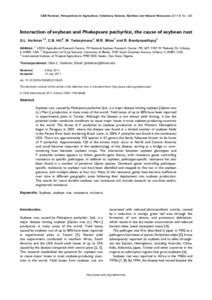| dc.contributor.author | Hartman, G.L. |
| dc.contributor.author | Hill, C.B. |
| dc.contributor.author | Twizeyimana, M. |
| dc.contributor.author | Miles, M.R. |
| dc.contributor.author | Bandyopadhyay, Ranajit |
| dc.date.accessioned | 2019-12-04T11:09:19Z |
| dc.date.available | 2019-12-04T11:09:19Z |
| dc.date.issued | 2011 |
| dc.identifier.citation | Hartman, G.L., Hill, C.B., Twizeyimana, M., Miles, M.R. & Bandyopadhyay, R. (2011). Interaction of soybean and Phakopsora pachyrhizi, the cause of soybean rust. CAB Reviews: Perspectives in Agriculture, Veterinary Science, Nutrition and Natural Resources, 6(25), 1-13. |
| dc.identifier.issn | 1749-8848 |
| dc.identifier.uri | https://hdl.handle.net/20.500.12478/2020 |
| dc.description.abstract | Soybean rust, caused by Phakopsora pachyrhizi Syd., is a major disease limiting soybean [Glycine max (L.) Merr.] production in many areas of the world. Yield losses of up to 80% have been reported in experimental plots in Taiwan. Although the disease is not always yield limiting, it has the potential under conducive conditions to cause major losses in most soybean-producing countries in the world. The threat of P. pachyrhizi to soybean production in the Western Hemisphere began in Paraguay in 2001, where the disease was found in a limited number of soybean fields in the Parana River basin bordering Brazil. Later, in 2004, P. pachyrhizi was found in the continental USA. There are approximately 150 species in 53 genera the family Fabaceae known to be hosts of P. pachyrhizi. Approximately 120 of the known hosts occur in North and Central America and could become important in the epidemiology of the disease, serving as a bridge or overwintering host between soybean crops. The interaction between soybean genotypes and P. pachyrhizi isolates appears to follow gene-for-gene theory, with resistance genes controlling resistance to specific pathotypes. In addition to soybean, pathotype-specific resistance has also been found in a number of perennial Glycine species. Dominant genes controlling pathotypespecific resistance to soybean rust have been identified and mapped to five loci in the soybean genome, with multiple alleles at four loci. Many of the resistance genes have become ineffective over time in different geographic areas following their deployment into soybean production. The search for more durable soybean rust resistance will include research on non-host and/or engineered resistance. |
| dc.description.sponsorship | United States Agency for International Development |
| dc.format.extent | 1-13 |
| dc.language.iso | en |
| dc.subject | Soybeans |
| dc.subject | Resistance |
| dc.subject | Virulence |
| dc.subject | Soybean Rust |
| dc.subject | Phakopsora Pachyrhizi |
| dc.subject | Yield Losses |
| dc.subject | Diseases |
| dc.title | Interaction of soybean and Phakopsora pachyrhizi, the cause of soybean rust |
| dc.type | Journal Article |
| dc.description.version | Peer Review |
| cg.contributor.affiliation | United States Department of Agriculture |
| cg.contributor.affiliation | University of Illinois |
| cg.contributor.affiliation | International Institute of Tropical Agriculture |
| cg.coverage.region | Africa |
| cg.coverage.region | East Africa |
| cg.coverage.region | Southern Africa |
| cg.coverage.region | West And Central Africa |
| cg.coverage.country | Congo, Dr |
| cg.coverage.country | Ghana |
| cg.coverage.country | Kenya |
| cg.coverage.country | Mozambique |
| cg.coverage.country | Nigeria |
| cg.coverage.country | Rwanda |
| cg.coverage.country | Uganda |
| cg.coverage.country | Zambia |
| cg.coverage.country | Zimbabwe |
| cg.authorship.types | CGIAR and advanced research institute |
| cg.iitasubject | Cowpea |
| cg.iitasubject | Food Security |
| cg.iitasubject | Grain Legumes |
| cg.iitasubject | Plant Diseases |
| cg.journal | Plant Sciences Reviews |
| cg.howpublished | Formally Published |
| cg.accessibilitystatus | Limited Access |
| local.dspaceid | 85780 |
| cg.targetaudience | Scientists |
| cg.identifier.doi | http://dx.doi.org/10.1079/pavsnnr20116025 |

